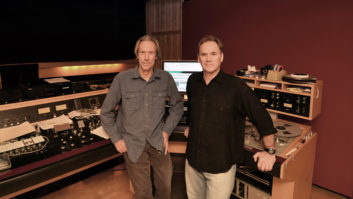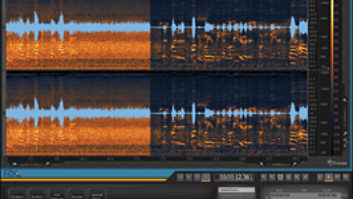Los Angeles, CA—Equipping a studio can be a lifelong quest for that ideal palette of colors, reflected in an ever-evolving suite of options as a facility’s gear is swapped out to make way for something newer, better or just different. Mastering engineer Maor Appelbaum’s search has included standard and modified units, customized and fully custom devices, and now, the design and manufacture of his own processing hardware brand.
“It’s good to stay the same in order to keep consistency, but at the same time, I do want to improve what I have,” says Appelbaum. “Just because I’m happy with the results in terms of the records sounding good doesn’t mean it can’t be better.”
Having a mastering console outfitted with the tools that meet his needs, and with which he is familiar, enables him to achieve the sound he’s seeking faster, Appelbaum explains, “because I can just move one knob that I know does the job that I like.”
But at the same time, trying something new, or bringing out an older, forgotten piece can bring a new perspective. “Just bringing it in opens something new that you didn’t have before. Maybe you almost got to that sound with something else, but now you have this new thing to get to that sound exactly.”
Related: More on Mastering with Maor Appelbaum, by Steve Harvey, Jan. 17, 2018
A mastering engineer’s sound is basically a combination of his or her decisions and the signal chain, he says. “If you want to get from point A to point B, or point Z, there are a lot of ways to get there. And by experimenting with different types of gear, you can find better routes.”
You might work with an equalizer for hours, carving frequencies, when simply running the signal through a different box will produce the desired result, he says. A good number of the devices in Appelbaum’s console do exactly that, acting as tone shapers, and often in subtle ways.
Take his Hendyamps Michelangelo equalizer, for example. For Appelbaum, “It’s a one-trick pony. It has a unique tone just by itself. Even flat, there’s a hi-fi feel, there’s a shaping to it. And when it fits, nothing else does it.”
Appelbaum is always amenable to trying new pieces and often tests new gear for manufacturers. Sometimes the attraction of a piece for him is only a small part of its feature set. The Bettermaker Mastering Equalizer is such a device, offering comprehensive functionality as well as recall abilities when tied to a DAW.
Related: Rethinking the Mastering Studio, by Steve Harvey, Jan. 4, 2018
The must-have feature for Appelbaum is the unit’s Pultec-like passive EQ, combined with the box’s digital control, which allows him to adjust by just fractions of a decibel, unlike the classic analog device. “The decimal increments help me a lot. Less than a decibel is enough—immediately you can hear there’s some weight to it. I used it on Eric Gales’ new record, The Bookends. I did a record for Today Is the Day and it was a huge part of the sound.”
His Thermionic Culture Phoenix compressor serves a similar purpose. “I use it less for compression and more as a tone box. On certain things, it gives you this feeling of ‘glue’ in the low end.”
Even his converter and clock options are there to provide appropriate coloration. “If something is edgy, or I want a vintage sound, the JCF Latte [D-to-A] works really well. It’s very smooth and has depth, like a tape sound,” he reports.
“I did a record for Adam Ben Ezra, an upright bass player who uses loops. This converter was one of the most important parts of the mastering. I didn’t do much processing—the converter was the tone shaper.”
Related: Engineers Think Global, Master Local, by Steve Harvey, March 12, 2015
He also bought his Burl Audio A-to-D converter for its specific sound: “I didn’t buy it to do conversion—I bought it to have another tone, instead of going to an equalizer.”
Appelbaum has a combination of clocking options, including an Antelope Audio 10MX and a Mutec with a REF 10 signal generator. “Again, it’s a tone shaper. I hook up the clock and I don’t need to cut the low end.”
For some, accepting that a clock can change the tone is a controversial issue, he says. “People don’t believe this, but forget about the specs and the null test. Just listen to it. You’ll see there is a difference.”
Not every off-the-shelf unit sounds the way he wants it to out of the box. “I modded my API 2500 compressor to sound better for my needs,” he says. His Overstayer M-A-S 1801 harmonic processor bears a suffix—MA—that indicates that it has been modified by the manufacturer for his needs.
Sometimes only a fully custom unit can do the job. “The Magic Death Eye is hands-down the best tube compressor I’ve heard—and I’ve heard a few,” says Appelbaum.
Related: Mastering Rock’s Past for the Future, by Steve Harvey, Dec. 19, 2016
Each box, made by Ian Sefchick, a mastering engineer who cuts vinyl at Capitol Studios, is built to order. “He did a special custom mod only he and I have,” says Appelbaum, who is mum on the details.
“I can’t say it’s on every project, but every project this was part of, it was the main shaper. It helped the tone, but not too much; it’s not aggressive. The gain is very clean, but you feel that there’s something there, like a halo or a peach fuzz.”
A recent addition to his setup is The Workshop LTD MA, a custom transformer and solid-state saturator/clipper built by Foote Control Systems with Appelbaum’s considerable design input. It was intended as the first product under the Maor Appelbaum Mastering brand name, but the cost and limited supply of some of the components used in the design mean that this will be a one-off box, he says.
So now he’s working with Roger Foote on The Bench, a similar but stripped-down design using less expensive parts that are easier to obtain. “It’s a work in progress and will be available in a few months,” predicts Appelbaum, who plans to also develop a plug-in version.
There is also a third custom unit coming—details are under wraps. Meanwhile, Appelbaum has recently provided some presets to Waves for its Abbey Road TG Mastering Chain plug-in. “I wrote seven,” he says. “And people are telling me they’re digging them.”
Maor Appelbaum Mastering • www.maorappelbaum.com
Foote Control Systems • www.footecontrolsystems.com
Want more stories like this? Subscribe to our newsletter and get it delivered right to your inbox.







